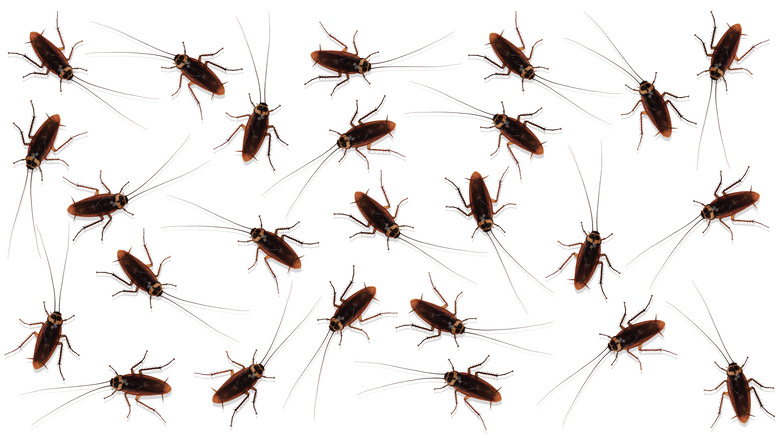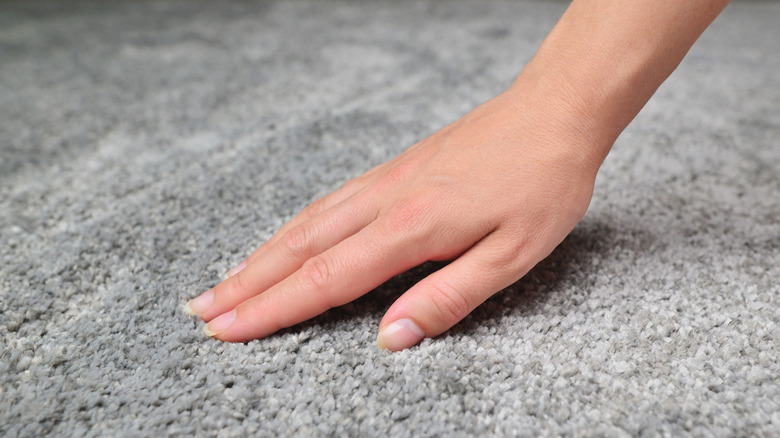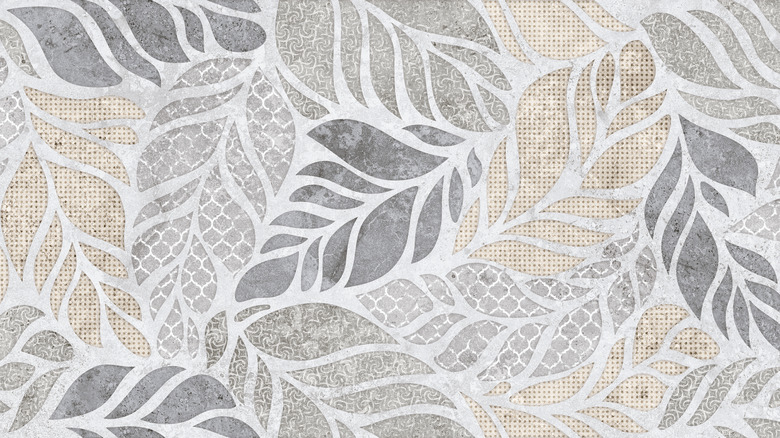Unexpected Common Triggers Of Indoor Allergies
If you have indoor allergies, you're definitely not alone. According to The American Academy of Allergy, Asthma & Immunology (AAAAI), the number of people affected by indoor allergens is in the millions. But just because you're aware that you have indoor allergies doesn't mean it's always obvious what's triggering them.
Of course, a good step to better understanding an allergy is learning how allergens affect your body. Let's use dust mites as an example. For some individuals, breathing in dust mites isn't going to cause any health issues. But for others, those dust mites set off their immune system, causing a chain of events that results in an allergic reaction (via AAAAI). And if you've ever had this happen to you, then you are probably all too familiar with its symptoms, which can include a runny nose, stuffiness, sneezing, and itchiness in different areas of the body like the eyes and the throat. What's more, the same allergens that can be the culprit behind allergies can also set off someone who has allergic asthma.
If you suspect you have an allergy, you should speak with a medical professional. But even if you know what you're allergic to, you still might need to do a little investigating to figure out what's triggering your attacks. So, we'll be exploring allergens, their hiding places, and even some irritants in your home that could be setting off allergy-like symptoms.
Hairless (and mostly hairless) pets
We often associate pet allergies with furry animals like fluffy cats and shaggy dogs — and for good reason. As the Mayo Clinic explains, a person might be allergic to their pet because they're reacting to proteins in the animal's saliva, urine, or dander. And as anyone who's ever given a dog or a cat a bath will tell you, these three things can become trapped in fur. But that doesn't mean animals with little or no hair or fur can't set off someone's allergies.
According to the American Kennel Club, the Xoloitzcuintli or Xolo is a breed of dog that (depending on the variety) can be hairless or only have a very small amount of hair on certain areas of the body. But while the lack of hair makes some Xolos less likely to trigger an allergic reaction, the same proteins that are the culprits behind those allergies are in (for example) a Xolo's saliva. This is why the American Kennel Club recommends spending time with a Xolo to make sure you don't have an allergic reaction before adopting one.
If you're more of a cat person but have pet allergies, you might think a Sphynx cat is the solution. But as WebMD explains, this type of cat can have some fur on their toes, their nose, their ears, and their tail. And while they, like Xolos, are less likely to set off allergies, that doesn't mean you can't have a reaction to them.
Cockroaches
No one wants cockroaches in their home. Just the idea of those fast-moving bugs crawling all over the kitchen or bathroom is enough to make one feel itchy. However, itchiness, as well as other physical reactions can be more than just psychological when it comes to roaches.
As the Asthma and Allergy Foundation of America (AAFA) explains, it's not uncommon for someone to be allergic to a protein found in the waste products, saliva, and body parts of cockroaches. In fact, even if the roach dies, it could still trigger this allergy. And besides making one's skin itchy, a person who's allergic to cockroaches might also experience itchiness in their throat, nose, or mouth. Additionally, they might have symptoms like a runny nose, postnasal drip, and watery eyes, as well as find themselves sneezing and/or coughing. And for someone with asthma who is allergic to cockroaches, they could have additional health issues, including tightness or pain in their chest, problems breathing, and might make wheezing or whistling noises as they exhale.
If you suspect there are cockroaches in your home, you should contact a professional pest control company. Furthermore, you should make sure there's no food left out for these little critters (via AAFA). These include not just crumbs or dirty dishes in the sink but also pet food in bowls. You also might want to opt for baits and traps for handling these little pests since sprays can be bad for someone with allergies or asthma.
Ferns
When we think of a plant setting off an allergy, we tend to zero in on pollen being the culprit behind the attack. And this isn't surprising since a good amount of advertising for allergy medications focuses on pollen allergies. However, plant allergies and pollen don't always go hand in hand.
Take ferns, for example. Despite not having flowers, ferns are popular choices for both homes and offices because their leaves give them an appealing appearance and because they can thrive in low-lighting conditions (per Clemson University). But as the U.S. Forest Service notes, ferns typically reproduce via spores. And according to Adult & Pediatric Allergy Associates, P.C., these spores could trigger an allergic reaction for someone with allergies or asthma, as well as possibly cause skin irritation. As a matter of fact, research in the Annals of Allergy tested spore extract from a widespread fern and concluded that "... allergists should be aware that ferns could be an important aeroallergen."
Although ferns are a potential trigger for allergies and asthma symptoms, they aren't the only houseplant you might want to avoid. For instance, Adult & Pediatric Allergy Associates, P.C., warns that the weeping fig is another one to watch out for because particles on various parts of the plant (like the sap and the leaves) can trigger an allergy attack. Symptoms can be similar to a latex allergy, which might include a scratchy throat, a runny nose, sneezing, coughing, wheezing, and breathing problems, via Mayo Clinic.
Scented candles
Imagine this: You're on an elevator with someone wearing way too much perfume or cologne. Chances are you'd find the situation very unpleasant, and the overpowering scent might even irritate your nose. But perfumes aren't the only things that can set off an allergy.
As WebMD points out, a scented candle can be the trigger behind an allergy attack. In fact, the fragrance from these types of candles can cause hay fever symptoms like a stuffy nose, sneezing, and coughing. What's more, you could experience a headache or a rash. However, the scent isn't the only possible culprit. According to eMedical Urgent Care, the smoke from scented candles can also be irritating to one's nasal passages. Plus, scented candles sometimes contain things like synthetic dyes and paraffin wax, as well as synthetic fragrances. These substances can lead to volatile organic compounds (VOCs) being released into the air. Now, you might have heard of VOCs since, as the Environmental Protection Agency (EPA) points out, different types of VOCs are either carcinogens or suspected carcinogens for humans. But they also can irritate a person's throat, eyes, and nose. And even after you've extinguished a candle, the soot from paraffin wax can leave particles in the air.
If you love scented candles, you do have some options. As eMedical Urgent Care notes, beeswax candles don't create as much soot, which could have a positive impact on one's allergies. You also might want to try non-toxic soy candles.
Carpeting (even if it's brand new)
Old, dusty carpeting in desperate need of a vacuuming or a good rug shampooing would seem like an obvious source of indoor allergens. And yes, a carpet in that condition should be thoroughly cleaned or replaced. However, even a brand-new carpet could be the culprit behind an allergy attack.
Before we go any further, it's important to talk about indoor air pollution and sick building syndrome. According to WebMD, particles in the air, as well as gases, can set off someone with allergies or asthma. As a matter of fact, indoor air pollution can cause issues like burning eyes, a stuffy nose, and coughing. Furthermore, if you have symptoms like feeling tired or having a headache and/or a scratchy throat when you're at work, and there are no other possible reasons like lack of sleep or stress, it could be you're experiencing sick building syndrome because of inadequate ventilation. Okay, but what does any of this have to do with a carpet? Well, when carpeting is new, it sometimes gives off compounds like formaldehyde. And if a room isn't ventilated well enough, those compounds could be the trigger behind an allergy attack.
While new carpeting might be problematic, carpeting, in general, is a favorite spot for a very common indoor allergen: dust mites (via American Academy of Allergy, Asthma & Immunology). For this reason, you might want to opt for washable rugs as opposed to carpeting for your home.
Laundry
Not every home has both a washer and a dryer. For some, that means going old school and hanging their laundry on a clothesline. But drying clothes outside in the sun isn't always an option, so one might hang or drape their wet laundry indoors. And this could be the beginning of allergy issues.
The Mackintosh School of Architecture conducted a study that found around a third of the moisture in the houses observed was because the residents were drying their laundry indoors, via BBC. Researcher Rosalie Menon noted that "Some were literally decorating the house with it [wet laundry], but from just one load of washing two litres of water will be emitted." The study, which involved different styles of houses, found that 75% of the homes involved in the study had moisture at levels that might be beneficial for dust mites. Additionally, mold spores and laundry drying indoors can go hand in hand, and according to the Mayo Clinic, it's possible to be allergic to the spores from mold. The study concluded that drying laundry indoors could be bad for individuals with allergies like hay fever, as well as some asthmatics.
If you don't own a clothes dryer, you might want to either dry your laundry outside or use a laundromat's dryers to avoid increasing the moisture in your home. But even if you own one, the Mayo Clinic advises having it vent its moisture outside.
Windows
If you open a window, you can let in pollen, which can trigger allergies. But even a shut window can be problematic since windows and what's on them can be breeding grounds for indoor allergens.
We often hear about mold and mildew in the same breath. A product, for example, might advertise that it gets rid of mold and mildew. But to manage indoor allergens, we need to know more about them than just their names. Mildew, for example, is a term for various types of fungus and mold and tends to thrive on windowsills (via the EPA). This is because moisture levels can be higher by the windows of homes, creating a perfect environment for mildew and, for that matter, mold. And, yes, both mold and mildew can trigger symptoms in patients with allergies or asthma, per WebMD. Additionally, heavy drapes that need to be dry cleaned, as well as blinds, can both trap dust and trigger allergy issues.
To reduce the chances of mold and mildew growing on your windows, WebMD recommends cleaning them regularly. The EPA states that a combination of water and detergent is an effective way to clean mold from hard surfaces. The Mayo Clinic advises replacing blinds with roller-type shades that are washable to reduce dust mites. Similarly, synthetic fabric curtains or plain cotton ones that don't require dry-cleaning might work better. And finally, you might want to add insulation to your windows to lessen condensation.
Wallpaper
For some, wallpaper is a way to hide flaws in a wall while giving a room an attractive accent. However, a specific type of indoor allergen could also be hiding behind those pretty patterns. With that said, just tearing the wallpaper off your walls could actually make the situation worse.
According to SFGate, when you have a room with high enough moisture and not sufficient ventilation, it can result in mold growing underneath the wallpaper. This typically occurs in rooms like the kitchen, the bathroom, and, as the University of Florida Health notes, the washroom and the basement. Now, you might be thinking, "okay, I'll just be extra careful when I take a shower," but it's a little more complicated than that. If an exterior wall of a house doesn't have a vapor barrier, then it can take in moisture, which gets trapped inside the wall because of the wallpaper and might result in mold and mildew. And, of course, once there's mold, there are mold spores that can trigger allergy symptoms.
If you believe you have mold behind wallpaper in your house, you might want to contact an expert and have them take care of it for you. However, if you do want to DIY this job, remember that just pulling off the wallpaper could spread the mold spores around. Instead, work slowly, invest in cleaning supplies and equipment like respirators and goggles, and remove furniture and other objects from the room before starting.
Paint
A fresh coat of paint can be very uplifting psychologically. Suddenly a room that was dull has a burst of new color. However, paint can also be a source of health issues, especially if you're the painter.
We can usually tell when a room's been freshly painted because of the smell of wet paint. However, according to Healthfully, paint fumes can cause symptoms like a sore throat, watery eyes, coughing, and congestion. Now, remember, there are both oil-based and water-based paints. And while the volatile organic compounds (VOCs) in oil-based paints might be a concern for allergy patients, that doesn't mean it's impossible to have a negative reaction to water-based paints. Also, if you like to DIY, keep in mind that for some people, touching paint could result in skin problems like burning, swelling, itchiness, discoloration, and/or a rash.
If you have any of the above reactions to paint, you might want to hire a professional painter. You can also use a paint that has low to no amounts of VOCs, per Healthfully. Additionally, wearing a mask and protective clothing like gloves can help reduce the chances of having a reaction. And if the room you're painting has a window, open it to help ventilate the paint's fumes. At the same time, you might want to close the door to the room so the fumes don't travel to other areas of your home.
Books
On the sitcom "Friends," Joey puts Stephen King's book "The Shining" in the freezer when reading it begins scaring him too much. While this is a comical character quirk, The American Library Association (ALA) recommends putting books in the freezer — just not for the same reason.
A person named David wrote to the ALA for advice on how to save his full set of the old Oxford English Dictionary from mold (via the ALA's website). As David explains, the dampness of the room the books were in caused mold to grow on the books' spines. Not only can mold be damaging to books, but as the Northeast Document Conservation Center notes, it can trigger an allergic reaction that can cause symptoms like a runny nose and eyes, congestion, sneezing, and coughing. And if a person has asthma, mold can trigger their condition. In addition, even if you don't have a mold allergy, you can develop one if you are overexposed to mold. So that seldom read book in a damp room in your home could be raising your chances of having health issues.
While alcohol can help treat moldy books, the person from the ALA advising David explained, "Once it [mold] sets in, it will come back, and there is almost nothing we can do safely in the home to completely prevent it from returning." However, she did say that freezing the book and then using alcohol can make it easier to remove the mold.
Rodents
Unless it's a family pet, most people would be very unhappy to find a mouse in their home. After all, finding food with tiny teeth marks or mouse droppings in the kitchen is a surefire way to lose one's appetite. Not to mention, some people are afraid of mice. Plus, these little critters, as well as other rodents like rats, can trigger allergic reactions.
According to the National Center for Healthy Housing (NCHH), allergens related to mice have been found in more than 80% of homes in the United States. What's more, saliva, skin, and urine from rodents are probably what contain the allergens. So, even if you get rid of a mouse, you could still experience allergic reactions if (for example) it's left droppings around your home. And, unfortunately, the bad news doesn't stop there. Research involving lab workers who interact with mice and rats has found that rodents can set off asthma attacks.
If you have a pest problem, calling in an expert might help get rid of unwanted rodents, as well as help safeguard your home against future infestations. However, you can also take steps to lower the chances of mice or rats invading your home. The NCHH recommends properly covering your trash cans or dumpster. You also should keep food in rodent-proof storage containers. And trees and bushes should be at least three feet from your home. Finally, look both inside and outside for any possible openings and properly seal them.
Cigarette smoke
According to Advanced ENT & Allergy Center, cigarette smoke isn't an allergen since it doesn't affect one's immune system like, for instance, dust mites. But it can still irritate your system and cause allergy-like symptoms. Plus, if you have hay fever, tobacco smoke might make your symptoms worse. And while secondhand smoke is a legitimate concern, it's not the only potential way someone could be being affected.
As the CDC explains, secondhand smoke can come from a variety of tobacco-based products and includes smoke that's breathed out by someone smoking (for instance) a cigarette. However, when a person smokes, all traces of their smoking doesn't disappear once they leave the room (via the National Institute on Drug Abuse). Instead, chemical residue can be left behind on places like drapes, bedding, furniture, and carpets, per the Thirdhand Smoke Resource Center. This is what's known as thirdhand smoke, and as pulmonologist Dr. Geoffrey Chupp told the Thirdhand Smoke Resource Center, even thirdhand tobacco smoke could trigger asthma attacks in some patients.
Of course, not smoking and asking others not to smoke in your home is the simplest way to avoid possible health issues. But let's face it. There will be times when you might not be able to avoid someone smoking in your home. If that's the case, the Thirdhand Smoke Resource Center recommends often cleaning furniture and items, as well as clothing, that might hold onto thirdhand smoke.
Stuffed Animals
While we usually associate stuffed animals with children, let's remember that anyone of any age could have contact with these plush critters on a regular basis. As The Washington Post points out, college students take stuffed animals away with them to the dorms. And grandparents might have stuffed toys in their homes for their grandkids' visits.
Yes, stuffed animals are very popular, but they also can be favorite locations for allergy-triggering dust mites, via The Washington Post. Of course, no one wants to tell a child that they can't keep a favorite stuffed animal. But depending on the severity of the allergy, that might not be necessary. Children's allergist Dr. Bonnie L. Renfro's four children have allergies, so she has each child pick a stuffed animal to be their "toy of the week." She told The Washington Post that "The toy each child chooses gets washed in hot water and put through the dryer. At the end of the week, that animal goes back to the laundry, or another is chosen and the first one put away."
Like clothing, you need to make sure the toy can be washed in hot water, per The Washington Post. And also, like clothes, washing toys might make them fade. For toys that aren't washable, you might want to only display them in (for instance) a stuffed animals' hammock or a glass-front bookcase. Finally, if your child has a dust mite allergy, speak with a medical professional about their stuffed animals.
Fireplaces
There's something special about a fireplace. With just a few logs, you can transform a cold room into a warm, cozy place. But you might want to think twice before throwing any type of wood on a fire.
Dr. Andrew Weil, the founder and director of the Andrew Weil Center for Integrative Medicine at the University of Arizona, notes on his website that the particles in smoke from wood burning in a fireplace can be bad for patients with asthma and chronic obstructive pulmonary disease (COPD). In fact, the Mayo Clinic recommends against using wood-burning fireplaces and stoves "because smoke and gases can worsen respiratory allergies." And the EPA explains that the microscopic particles in wood smoke can cause health issues like a runny nose and burning eyes, as well as more serious conditions like bronchitis, heart attacks, and stroke.
On the bright side, the Mayo Clinic notes that natural gas fireplaces are less likely to "worsen respiratory allergies." But if you do have a wood-burning fireplace, then keeping it and the chimney clean is essential not just because of the potentially harmful effects of wood smoke but also because not keeping up with chimney maintenance can raise the possibility of a chimney fire. You might want to also explore artificial logs that specifically advertise emitting lower amounts of particles in the smoke.















